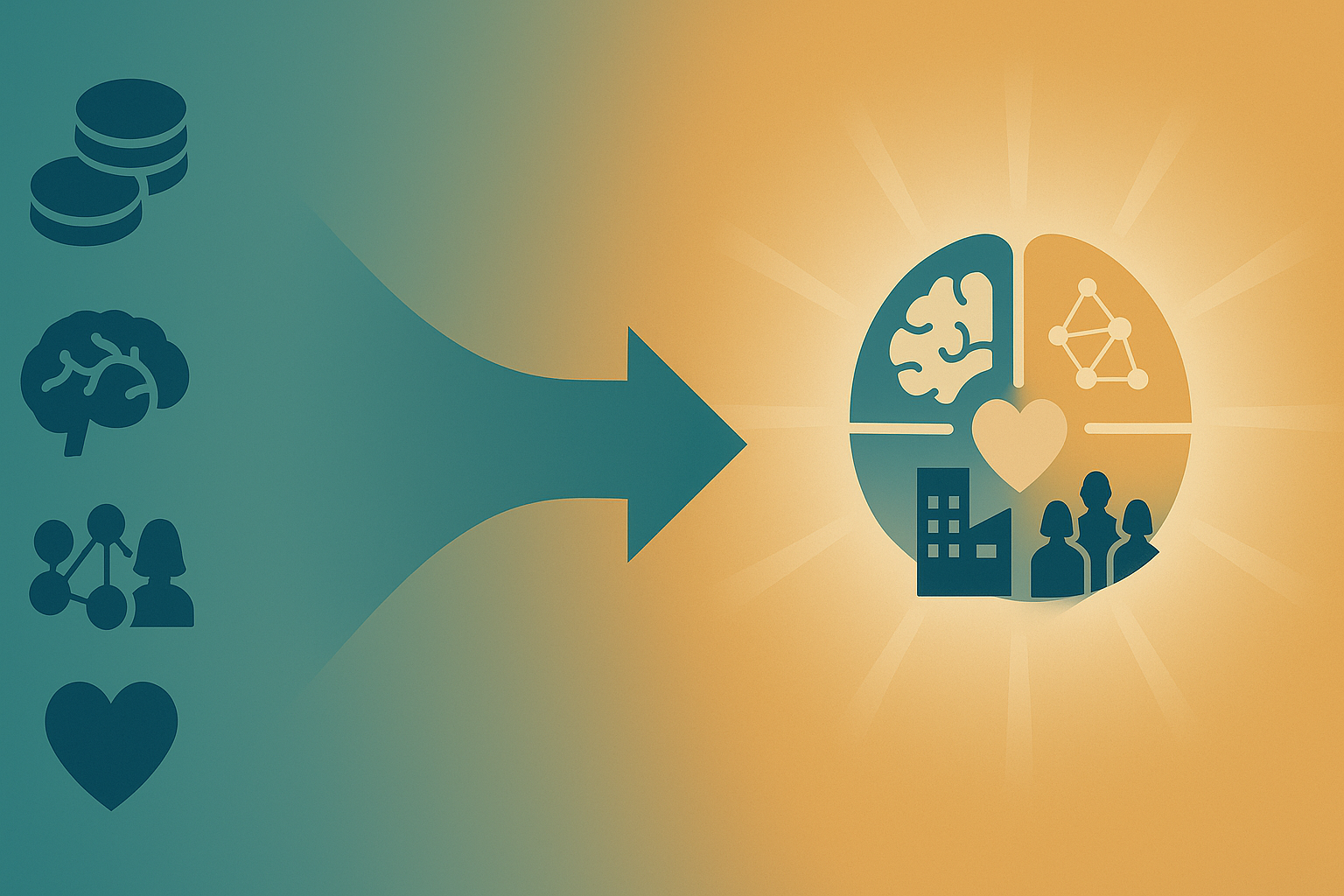|
|
Conclusion
 In a rapidly
evolving world, well-being and success cannot be explained by money
or know-how alone. The
4Capital lens—material,
intellectual,
social, and
spiritual—offers a
clear, modern framework for the holistic development of individuals,
organizations, and nations. When these four forms of capital are
cultivated in balance, they reinforce one another, enabling life
satisfaction, resilient organizational performance, and humane
national progress. In a rapidly
evolving world, well-being and success cannot be explained by money
or know-how alone. The
4Capital lens—material,
intellectual,
social, and
spiritual—offers a
clear, modern framework for the holistic development of individuals,
organizations, and nations. When these four forms of capital are
cultivated in balance, they reinforce one another, enabling life
satisfaction, resilient organizational performance, and humane
national progress.
1) Four forms of capital
-
Material capital
— funds, equipment, buildings, land, inventories,
infrastructure, and natural assets. In today’s world this also
includes energy systems,
digital connectivity, and computing capacity that
enable nearly all activity.
-
Intellectual capital
— knowledge, skills, creativity,
data and software,
organizational processes, relationships that carry know-how, and
protected intellectual
property (patents, copyrights, trademarks).
-
Social capital
— trust, norms of reciprocity, and networks. It includes
bonding ties
(reliability within groups),
bridging ties
(connections across groups), and
linking ties
(connections across levels of power and institutions).
-
Spiritual capital
— purpose, values, and meaning that guide behavior.
For believers,
this can be connectedness with God;
for others,
commitment to noble purposes and moral standards. When values
shape habits and
institutions, they become usable capital. (See also the
author’s inclusive
Spiritual Capital Index (SPI) concept.)
2) The necessity of the
optimal 4Capital combination
Results
arise from the combination
of capitals, not from any single one alone. Overemphasis on one
capital—money without trust, knowledge without ethics, or community
without resources—creates new problems. A
balanced mix
achieves more:
-
Material
invests in capability.
-
Intellectual
turns ideas into improvements.
-
Social
enables cooperation and lowers friction.
-
Spiritual
keeps direction and conduct aligned with worthy goals.
This logic
holds at every level:
Individuals
(security, learning, belonging, purpose) •
Organizations
(operations, know-how, culture and partners, mission and ethics) •
Nations
(infrastructure and stewardship, education and innovation, civic
trust, shared values).
3) The imperative for
4Capital transformation
Transformation means
developing all four capitals together—practically and over
time.
-
See clearly:
name current strengths and constraints in each capital (one page
per capital).
-
Balance, don’t
maximize: strengthen the
weakest
capital first; invest in
complements
(pair tools with training; policies with relationships; budgets
with purpose).
-
Make it visible:
turn values into routines (rituals, norms, simple promises) and
knowledge into
shareable practices (guides, checklists, wikis).
-
Maintain what matters:
keep assets reliable; keep knowledge fresh; keep relationships
healthy; keep purpose present.
-
Review regularly:
brief monthly/quarterly/annual check-ins; prefer a
few good signs
over many weak ones.
-
Safeguards:
fairness and inclusion; transparent choices and kept promises;
privacy-aware use of digital records; responsible
data and AI
practices; stewardship of land, water, energy, and cultural
heritage.
4) Conclusion
The
4Capital perspective offers a clear path for the years ahead:
align resources,
knowledge, relationships, and values so people flourish,
organizations perform, and societies cohere. Small, steady
steps—reliable basics, shared learning, trusted cooperation, and
purpose in action—compound into durable capability.
Note: The work
presented here includes research conducted by Dr. Alex Liu at
Stanford University and that for the Global Entrepreneurship
Monitoring initiative. Dr. Alex Liu greatly benefited from valuable
discussions with several accomplished authors, including Danah
Zohar, author of 'Spiritual Capital'; Ernie Chu, author of 'Soul
Currency'; Theodore Roosevelt Malloch, author of 'Spiritual
Enterprise'; and Lawrence M. Miller, author of 'The New Capitalism'.
Note:
To cite us, please write "Liu, Alex. 4Capital and
Performance, RM Publishing, 2008, ResearchMethods.org,
https://www.researchmethods.org/4capital.htm.
|